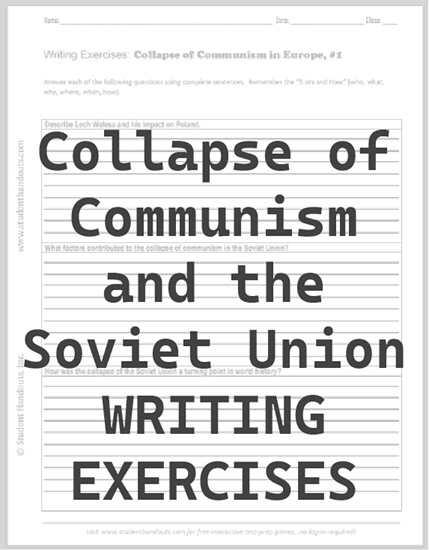| Collapse of Communism Writing Exercises Worksheets |
|---|
| World History ↣ Collapse of Communism ↣ Collapse of Communism Printable Worksheets |
 |
    |
|
Collapse of Communism Writing Exercises Worksheet #1 - Answer each of the following questions using complete sentences.
1. Describe Lech Wałęsa and his impact on Poland. Lech Wałęsa, a co-founder of Solidarity (Solidarność), was a pivotal figure in Poland's anti-communist movement. His leadership during the 1980s strikes and negotiations with the communist regime led to democratic reforms. Awarded the Nobel Peace Prize (1983), Wałęsa became Poland's first democratically elected president (1990-1995), steering the country toward market economy and N.A.T.O. integration. His legacy remains debated but undeniably shaped Poland's transition to democracy. 2. What factors contributed to the collapse of communism in the Soviet Union? The collapse of Soviet communism resulted from: ↳ Economic stagnation under central planning ↳ Massive military spending (e.g., Afghan War, arms race) draining resources ↳ Gorbachev's reforms (glasnost and perestroika), which weakened party control ↳ Rising nationalist movements in Soviet republics ↳ Loss of Eastern European satellite states (e.g., Poland's Solidarity movement) ↳ Public disillusionment and protests ↳ The 1991 hardliner coup attempt, which accelerated disintegration These factors combined to dissolve the U.S.S.R. by December 1991. 3. How was the collapse of the Soviet Union a turning point in world history? The Soviet Union's 1991 collapse ended the Cold War, leaving the U.S. as the sole superpower and reshaping global geopolitics. It dissolved the bipolar world order, spurred N.A.T.O. and E.U. expansion, and enabled the spread of democracy and capitalism in Eastern Europe. Former Soviet states faced turbulent transitions, while Russia struggled with diminished influence. The event also marked the decline of communism as a global ideological force. Click here to print. Answers will vary. |
|
Collapse of Communism Writing Exercises Worksheet #2 - Answer each of the following questions using complete sentences.
1. Describe the flaws in the Soviet Union's command economy. The Soviet command economy was plagued by inefficiency due to rigid central planning, which stifled innovation and misallocated resources. Production quotas prioritized quantity over quality, causing chronic shortages of consumer goods. Bureaucratic corruption and lack of price signals led to waste and stagnation. The system's inability to adapt to technological advances or global markets weakened competitiveness, ultimately contributing to economic decline and the U.S.S.R.'s collapse. 2. What troubles have been faced by Russia in the move toward capitalism? Russia's shift to capitalism brought severe challenges: ↳ Economic turmoil: Shock therapy in the 1990s caused hyperinflation, poverty, and G.D.P. collapse. ↳ Oligarchic control: State assets were privatized cheaply, creating a wealthy elite while inequality soared. ↳ Corruption and crime: Weak institutions led to rampant graft and mafia dominance. ↳ Dependence on resources: Overreliance on oil/gas exports left the economy vulnerable to price swings. ↳ Political backlash: Discontent fueled authoritarianism, reversing democratic reforms. 3. How did the fall of the Soviet Union impact Cuba? The USSR's collapse devastated Cuba's economy, ending Soviet subsidies (worth $4-$6 billion annually) and triggering the "Special Period" crisis. Trade with the Eastern Bloc collapsed, causing severe shortages of food, fuel, and medicine. Cuba lost its main ally, forcing limited market reforms to survive. Politically, Havana clung to communism but faced growing isolation and U.S. pressure. The crisis reshaped Cuba's economy and foreign relations. Click here to print. Answers will vary. |
| World History ↣ Collapse of Communism ↣ Collapse of Communism Printable Worksheets |








